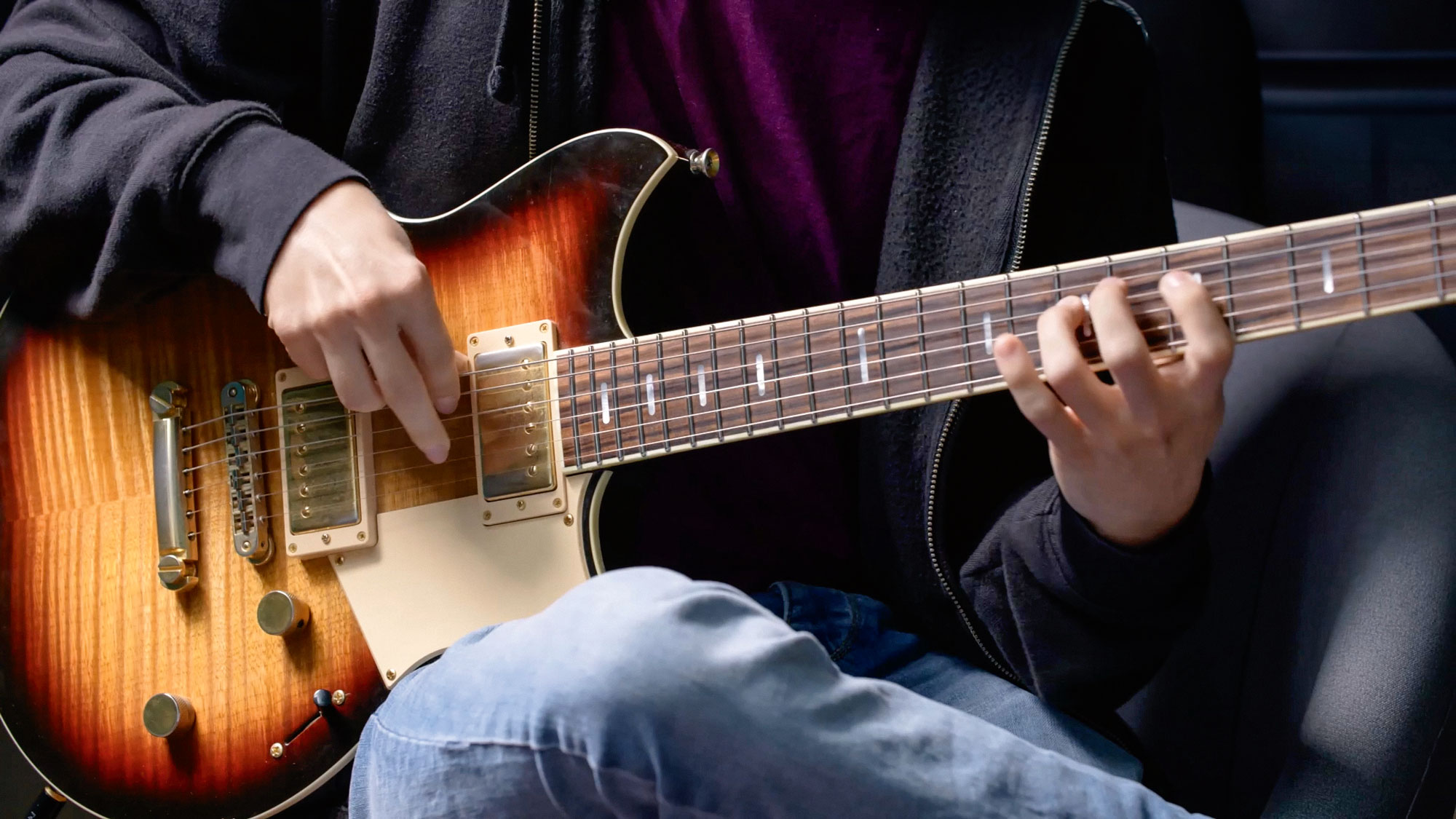
A born and bred Sicilian, Matteo Mancuso hails from the city of Palermo and has recently gained international acclaim, receiving high praise from many of the guitar world’s luminaries including Steve Vai and Joe Bonamassa who have applauded his versatility and brilliance at taking the instrument to a new level.
Al Di Meola was so enthralled by him that he invited Mancuso on stage to duet with him at the Eddie Lang Jazz Festival in 2022.
Aside from his jaw-dropping virtuosic and lyrical writing style, it is Mancuso’s distinctive technique that turns many guitarists’ heads. This technique didn’t simply appear out of nowhere but is rather a product of his technical and musical influences thus far.
Mancuso started playing electric guitar at the age of 10 guided by his father, the guitarist and producer Vincenzo Mancuso, who introduced Matteo to rock and jazz.
At this early age Matteo first began exploring the guitar by plucking with his fingers and, luckily for us, he admits in interviews that he was too lazy to learn how to play with a pick as fingerstyle felt more intuitive. This approach was only solidified further when as a high school student aged 14 he began formally learning classical guitar.
Like any true artist, academics weren’t Mancuso’s forte and he failed his second year of music school, ironically because he spent nine hours a day practising guitar!
This dedication saw him being awarded a scholarship to Berklee College of Music after taking part as a student at Umbria Jazz Festival, though he instead opted to remain in his home city to continue his studies, graduating with honours from the jazz guitar programme at Palermo Conservatory of Music in June 2022.
The theories and technique from his exposure to classical guitar have filtered through into the music he creates; a mixture of modern fusion jazz-rock-blues (although it’s almost impossible to pigeonhole Mancuso).
As will be explored throughout the 12 examples, Matteo opts for a classical plucking hand as the main staple in how he reaches the speeds he so comfortably achieves. Be sure to take in the comments for each example and keep a close eye on the fingerings to maximise efficiency.
Technique Focus: The Midas touch
The key approach Mancuso employs is the use of his ‘classical’ plucking hand over a pick. He adopts something many classical guitarists call the Golden Hand Position, whereby you hold the hand in a single ‘default’ position that allows for instant access to any string on the guitar; achieved by cupping your plucking hand into a relaxed shape and floating the tips of the ‘i’, ‘m’, and ‘a’ fingers diagonally over the third, second, and first string (in that order) while the tip of the thumb hovers over the three bass strings.
If you keep the back of your hand static when plucking, this technique allows for secure and reliable access to notes, whether scalic or arpeggiated.
Get the tone
Amp Settings: Gain 3, Bass 7, Middle 6, Treble 7, Reverb 2
Matteo is faithful to his Yamaha Revstar guitars with their total access fretboards and fat humbucking pickups. But perhaps the greatest contributor to his tone is the use of fingers to pluck rather than using a guitar pick. The warmth provided by flesh against the strings is palpable, plus thumb and fingers are necessary to get close to his technique.
Example 1
In this example, we are exploring rest stroke plucking technique. Hold your plucking hand back slightly and keep your fingers a little flat.
When cycling through a-m-i-a-m-i picking for three note per string lines (clearly seen in bar 1 into 2), after one finger plucks kick the next finger up, so you always have one finger cocked and ready; this will help playing at higher tempos.
Try this idea at first with only i-m-i-m, kicking the adjacent finger up as the other plucks.
Example 2
For free stroke plucking, we position our plucking hand more forward compared to rest stroke. The secret to a consistent and confident technique is keeping that position static.
Cup your palm while keeping the thumb out in front, and don’t let the thumb end up behind the fingers as you can end up tying them in knots! In classical free stroke, the thumb generally tends to the three bass strings while the i, m, and a fingers deal with the top three strings.
For this example, your floating plucking hand location should allow the i, m, and a fingers easy access to the top three strings while the thumb hovers over the lower three strings.

Example 3
This example fuses classical alternating i-m finger pattern technique with the raking technique to make string crossing easier; when we move down from one string to the next we essentially ‘drag’ the first finger like we would a pick before continuing the alternating i-m pattern. Economy picking isn’t just for plectrum players!
Example 4
Here we are taking the classical free stroke technique, sticking to a simple i-m pattern but instead playing that across all strings.
To make this technique more secure, keep your thumb resting on the string behind the one that is getting plucked; for example when you are plucking the third string rest the thumb on the fourth string.
As you move up and down the strings, quietly relocate the thumb to the next string.
Example 5
Here we are exploring economy of motion in the fretting hand in the pursuit of minimising tension and maintaining legato connection between notes.
Make the fretting-hand movements as fluid as possible by avoiding ‘stressy’ jerking motions; instead, expand and contract the handspan to reach nearby notes instead of shifting the hand itself.
Where shifts can’t be avoided (such as the chords at the end) keep the fingers light as you add each note back on.
Example 6
In this example, we are continuing the economy of motion concept and minimising pressure in the fretting hand.
Try applying the ‘click fix’ to this passage: spend time playing through all notes with almost zero pressure, as though you are trying to play everything as a harmonic, all the while plucking with a strong tone.
Once comfortable, you’ll be surprised how little pressure you actually need to put back into the fingers in order for the notes to sound clean.
Example 7
This example is about keeping a wide span between the first and fourth fingers. A standard classical approach would endorse a middle of the neck fretting-hand thumb position throughout.
If you raise the thumb higher than this (ie much closer to the low strings) it restricts the distance achievable between the first and fourth fingers. This is a main reason for ‘classical posture’, as it’s more ergonomic to maintain this low fretting-hand thumb position with the neck raised slightly.
Example 8
Here Matteo explores pitch bending and bluesy inflections. There is a lot of cross-string movement in the phrasing of this passage so a free stroke plucking-hand position is required for this.
Example 9
Here we combine blues-style pitch bending with G minor pentatonic notes and mordent-style grace notes. Keep the fretting hand light as you execute these grace notes, and aim to make the double-grace notes into the last G of bar 1 come from one motion in the second finger.
Example 10
Lots of cross-string movement here, so continue to apply the free stroke fretting-hand approach.
As in example 4 we are moving up and down the strings with a predominantly i-m finger pattern so keep the your thumb resting on the string below that being plucked to make the plucking hand feel more secure.
Example 11
Keep focused on your economy of motion here. In the fretting hand there are lots of instances where we can get away without shifting and can instead extend or contract our hand span to reach nearby notes.
For the a-m-i patterns practise them in isolation before bringing into the rest of the notes.
Example 12
In this final insight into Mancuso’s vocabulary we explore 4th intervals across the fretboard. When we play groups of three, pluck i-m-a, and as we change to groups of four switch to m-i-m-a.
Once you reach the halfway point of bar 2, rest your thumb on the fourth string for the remainder of the example to feel super-secure. Although there’s a lot of work for you in this feature, the rewards you will reap in terms of musicality and technique cannot be overstated. Enjoy!







